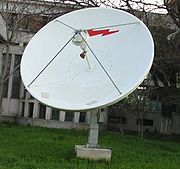.gif)
Reflector (antenna)
Encyclopedia

Reflection (physics)
Reflection is the change in direction of a wavefront at an interface between two differentmedia so that the wavefront returns into the medium from which it originated. Common examples include the reflection of light, sound and water waves...
electromagnetic waves.
It is often a part of an antenna
Antenna (radio)
An antenna is an electrical device which converts electric currents into radio waves, and vice versa. It is usually used with a radio transmitter or radio receiver...
assembly.
The most common reflector types are
- a passive elementPassive radiatorIn a radio antenna, a passive radiator or parasitic element is a conductive element, typically a metal rod, which is not electrically connected to anything else. Multielement antennas such as the Yagi-Uda antenna typically consist of a "driven element" which is connected to the radio receiver...
slightly longer than and located behind a radiating dipole element that absorbs and re-radiates the signal in a directional way as in a Yagi antenna array. - corner reflectorCorner reflectorA corner reflector is a retroreflector consisting of three mutually perpendicular, intersecting flat surfaces, which reflects waves back directly towards the source, but shifted . Unlike a simple mirror, they work for a relatively wide-angle field of view. The three intersecting surfaces often have...
which reflects the incoming signal back to the direction it came from - parabolic reflectorParabolic reflectorA parabolic reflector is a reflective device used to collect or project energy such as light, sound, or radio waves. Its shape is that of a circular paraboloid, that is, the surface generated by a parabola revolving around its axis...
which focuses a beam signal into one point, or directs a radiating signal into a beam - flat reflector which just reflects the signal like a mirror and is often used as a passive repeaterPassive repeaterA passive radio link deflection, or passive repeater is a plant for the implementation of a microwave link, in which because of an obstacle in the signal path no direct line of sight microwave link is possible...
Design criteria
Parameters to be taken into account include the following that directly influence efficiency:- Spillover (part of the feed antenna radiation misses the reflector)
- ApertureApertureIn optics, an aperture is a hole or an opening through which light travels. More specifically, the aperture of an optical system is the opening that determines the cone angle of a bundle of rays that come to a focus in the image plane. The aperture determines how collimated the admitted rays are,...
blockage (also known as feed blockage: part of the feed energy is reflected back into the feed antenna and does not contribute to the main beam) - Illumination taper
- Reflector surface deviation
- Defocusing
- Cross polarization
- Feed losses
- Antenna feed mismatch
- Non-uniform amplitude/phase distributions
- Big ugly dish
The antenna efficiency is measured in terms of its effectiveness ratio.
Any gain degrading factors which raise side lobe
Side lobe
In antenna engineering, side lobes or sidelobes are the lobes of the far field radiation pattern that are not the main lobe....
s have a two-fold effect, in that they contribute to system noise temperature in addition to reducing gain. Aperture blockage and deviation of reflector surface (from the designed "ideal") are two important cases. Aperture blockage is normally due to shadowing by feed, subreflector and/or support members. Deviations in reflector surfaces cause non-uniform aperture distributions, resulting in reduced gains.
The standard symmetrical, parabolic, Cassegrain reflector
Cassegrain reflector
The Cassegrain reflector is a combination of a primary concave mirror and a secondary convex mirror, often used in optical telescopes and radio antennas....
system is very popular in practice because it allows minimum feeder length to the terminal equipment. The major disadvantage of this configuration is blockage by the hyperbolic sub-reflector and its supporting struts (usually 3 - 4 are used). The blockage becomes very significant when the size of the parabolic reflector is small compared to the diameter of the sub-reflector.
To avoid blockage from the sub-reflector asymmetric designs such as the open Cassegrain can be employed. Note however that the asymmetry can have deleterious effects on some aspects of the antenna's performance - for example, inferior side-lobe levels, beam squint, poor cross-polar response, etc.
To avoid spillover from the effects of over-illumination of the main reflector surface and diffraction
Diffraction
Diffraction refers to various phenomena which occur when a wave encounters an obstacle. Italian scientist Francesco Maria Grimaldi coined the word "diffraction" and was the first to record accurate observations of the phenomenon in 1665...
, a microwave absorber is sometimes employed. This lossy material helps prevent excessive side-lobe levels radiating from edge effects and over-illumination. Note that in the case of a front-fed Cassegrain the feed horn and feeder (usually waveguide) need to be covered with an edge absorber in addition to the circumference of the main paraboloid.

